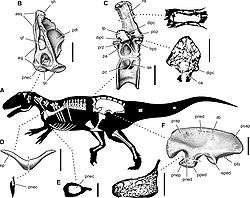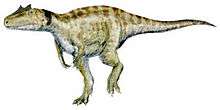Aerosteon
| Aerosteon Temporal range: Late Cretaceous, 84 Ma | |
|---|---|
 | |
| Skeletal diagram illustrating air-filled bones | |
| Scientific classification | |
| Kingdom: | Animalia |
| Phylum: | Chordata |
| Class: | Reptilia |
| Clade: | Dinosauria |
| Order: | Saurischia |
| Suborder: | Theropoda |
| Family: | †Neovenatoridae |
| Clade: | †Megaraptora |
| Genus: | †Aerosteon Sereno et al., 2009 |
| Type species | |
| †Aerosteon riocoloradense Sereno et al., 2009 | |
Aerosteon is a genus of megaraptoran dinosaur from the Late Cretaceous period of Argentina. Its remains were discovered in 1996 in the Anacleto Formation, dating to the Santonian stage (about 84 million years ago). The type and only known species is A. riocoloradense. Its specific name indicates that its remains were found 1 km (0.6 miles) north of the Río Colorado, in Mendoza Province, Argentina.
They show evidence of a bird-like respiratory system.[1] Aerosteon's name can be translated as air bone and derives from Greek ἀήρ (aer, "air") and ὀστέον (osteon, "bone"). Though the species name was originally published as "riocoloradensis", Greek ὀστέον is neuter gender, so according to the ICZN the species name must be riocoloradense to match.
Description

Aerosteon was a 9 metre (30 ft) long, 2 metric ton bipedal carnivorous dinosaur that lived approximately 83 million years ago during the Santonian stage.
The remains discovered include a single tooth, some cranial bones, a number of partial or complete vertebrae from the neck, back, and sacrum, several cervical and dorsal ribs, gastralia, furcula (wishbone), left scapulocoracoid, left ilium, and left and right pubes. The incomplete fusion of some of its bones indicate that it was not quite fully mature.
Aerosteon did not initially appear to belong to any of the three groups of large theropods that were known to have inhabited the southern continents during this time (namely the Abelisauridae, Carcharodontosauridae or Spinosauridae). Sereno suggested that it might be related to the allosauroid radiation of the Jurassic period, and this was supported in subsequent studies that recognized a clade of late-surviving, lightly built, advanced allosauroids with large hand claws similar to the spinosaurs, called the Megaraptora, within the allosaur family Neovenatoridae.[2] A later analysis has placed Megaraptora, including Aerosteon, within the Tyrannosauroidea.[3] Megaraptorans have since been also considered as non-tyrannosauroid basal coelurosaurs in some analyses.[4][5]
Physiology

Some of Aerosteon's bones show pneumatisation (air-filled spaces), including pneumatic hollowing of the furcula and ilium, and pneumatisation of several gastralia, suggesting that it may have had a respiratory air-sac system similar to that of modern birds. These air sacs would have acted like bellows, moving air into and out of the animal's relatively inflexible lungs, instead of the lungs themselves being expanded and contracted as occurs with mammals. See avian respiratory system for more detailed information on this.
Sereno theorises that this respiratory system may have developed to assist with regulating body temperature and was later co-opted for breathing.[1]
Classification and naming
Aerosteon was first described by Sereno et al. in a paper which appeared in the online journal PLoS ONE in September 2008. However, at the time, the International Code of Zoological Nomenclature did not recognize online publication of names for new species as valid unless print copies were also produced and distributed to several libraries, and that this action is noted in the paper itself. PLoS ONE initially failed to meet this requirement for Aerosteon. On 21 May 2009, the journal's managing editor coordinated with the ICZN to correct this oversight, publishing a comment to the original paper with an addendum stating that the requirements had been met as of that date. Consequently, though the description appeared in 2008, Aerosteon was not a valid name until 2009.[6]

The cladogram below follows the 2010 analysis by Benson, Carrano and Brusatte, which considered megaraptorans as tetanurans.[2]
| Neovenatoridae |
| |||||||||||||||||||||||||||||||||||||||
| |
The cladogram shown below follows an analysis by Porfiri et al., 2014, which recovered megaraptorans as tyrannosauroids.[8]
| Megaraptora |
| |||||||||||||||||||||
| |
References
- 1 2 Sereno, P.C., Martinez,R.N., Wilson, J.A., Varricchio, D.J., Alcober, O.A., and Larsson, H.C.E. (2008). Kemp, Tom, ed. "Evidence for Avian Intrathoracic Air Sacs in a New Predatory Dinosaur from Argentina". PLoS ONE. 3 (9): e3303. Bibcode:2008PLoSO...3.3303S. doi:10.1371/journal.pone.0003303. PMC 2553519
 . PMID 18825273.
. PMID 18825273. - 1 2 Benson R.B.J.; Carrano M.T; Brusatte S.L. (2010). "A new clade of archaic large-bodied predatory dinosaurs (Theropoda: Allosauroidea) that survived to the latest Mesozoic". Naturwissenschaften. 97 (1): 71–78. Bibcode:2010NW.....97...71B. doi:10.1007/s00114-009-0614-x. PMID 19826771.
- ↑ F. E. Novas; F. L. Agnolín; M. D. Ezcurra; J. I. Canale; J. D. Porfiri (2012). "Megaraptorans as members of an unexpected evolutionary radiation of tyrant-reptiles in Gondwana". Ameghiniana. 49 (Suppl.): R33.
- ↑ Apesteguía, S; Smith, N.D.; Valieri, R.J.; Makovicky, P.J. (2016). "An Unusual New Theropod with a Didactyl Manus from the Upper Cretaceous of Patagonia, Argentina". PLoS ONE. 11 (7): e0157793. doi:10.1371/journal.pone.0157793.
- ↑ Novas, F.E.; Aranciaga Rolando, A.M.; Agnolín, F.L. (2016). "Phylogenetic relationships of the Cretaceous Gondwanan theropods Megaraptor and Australovenator: the evidence afforded by their manual anatomy" (PDF). Memoirs of Museum Victoria. 74: 49–61.
- ↑ PLoS ONE Group (2009). "Steps taken to meet the requirements of the ICZN to make new taxonomic names nomenclaturally available." Comment on Original Article: "Evidence for Avian Intrathoracic Air Sacs in a New Predatory Dinosaur from Argentina." PLoS ONE, 21 May 2009.
- ↑ Zanno, L. E.; Makovicky, P. J. (2013). "Neovenatorid theropods are apex predators in the Late Cretaceous of North America". Nature Communications. 4: 2827. Bibcode:2013NatCo...4E2827Z. doi:10.1038/ncomms3827. PMID 24264527.
- ↑ Juan D. Porfiri; Fernando E. Novas; Jorge O. Calvo; Federico L. Agnolín; Martín D. Ezcurra; Ignacio A. Cerda (2014). "Juvenile specimen of Megaraptor (Dinosauria, Theropoda) sheds light about tyrannosauroid radiation". Cretaceous Research. 51: 35–55. doi:10.1016/j.cretres.2014.04.007.
External links
- New Birdlike Dinosaur Found in Argentina
- Meat-eating dinosaur had bird-like breathing
- Dinosaur predator breathed like a modern bird